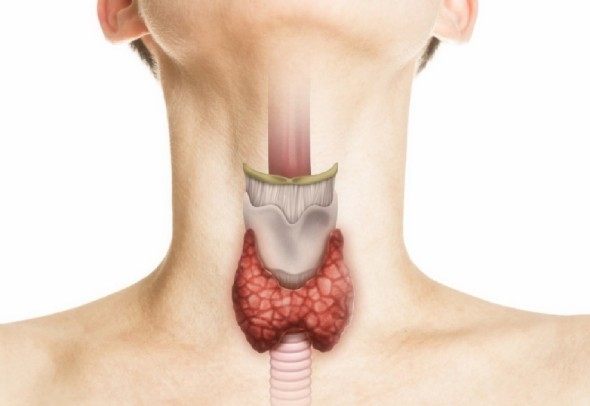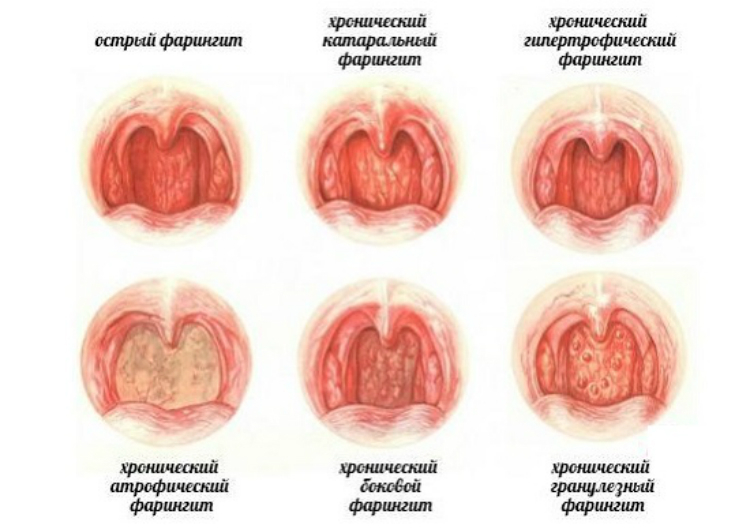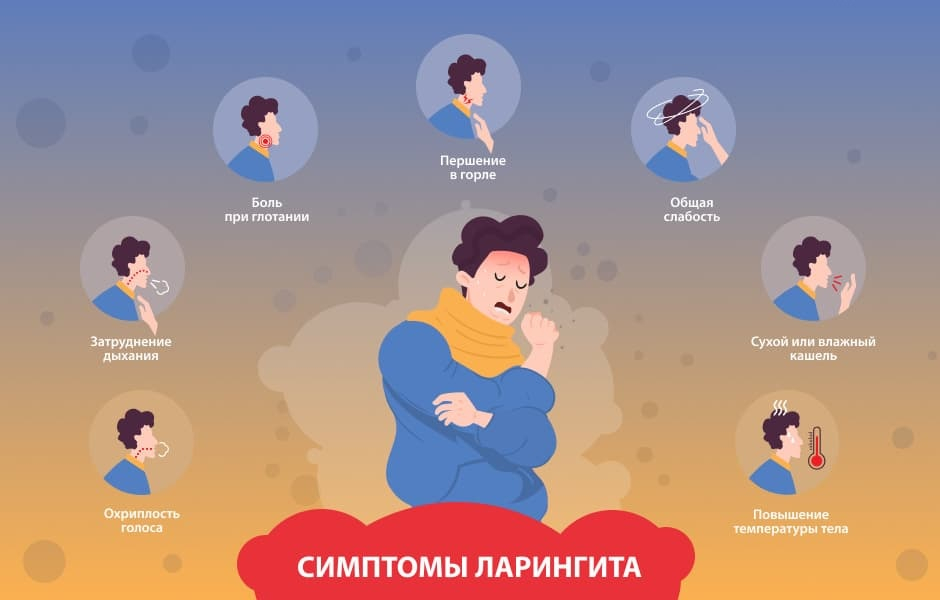Laryngitis: everything about laryngitis and its treatment.

Symptoms of laryngitis, such as dryness and irritation in the throat, a throaty cough, and hoarseness, are familiar to many. Laryngitis is one of the most common throat conditions. We will discuss the causes, distinctive features, and treatment methods of this condition.
Definition of laryngitis
Laryngitis is an inflammatory condition of the larynx and vocal cords. The larynx is part of the respiratory system, located in the upper part of the neck, below the nasopharynx and in front of the trachea, separated from the pharynx by the epiglottis. Swelling and inflammation of the vocal cords lead to hoarseness and voice loss.
Laryngitis can affect the vocal cords, the mucous membrane of the larynx, or the entire larynx. A significant diagnostic feature is the swelling of the laryngeal tissues, which can be dangerous, especially in children, as it can obstruct breathing. Acute laryngitis is assigned the code J04 in the ICD-10, acute obstructive laryngitis - J05, chronic laryngitis - J37.
Causes of laryngitis
Laryngitis can be of infectious or non-infectious origin.
The main cause is infections, most commonly viral, but bacterial and fungal infections are also possible. Laryngitis can be caused by overcooling, including inhaling cold air, as well as by a common cold. Viral and bacterial infections are transmitted by contact.
Laryngitis is most often caused by rhinovirus, influenza viruses, parainfluenza virus, adenovirus, coronavirus, RSV, enteroviruses, bocavirus, metapneumovirus.
Bacterial laryngitis is less common and often occurs in combination with viral infection due to weakened immunity. The most common bacteria causing laryngeal inflammation are streptococci A and C, coccobacilli, diphtheria bacillus, hemophilic infection, pertussis, and others.
Fungal laryngitis is rare, accounting for up to 10% of cases of acute laryngitis, usually occurring with weakened immunity or after taking antibiotics and corticosteroids.
Laryngitis often occurs as a complication of other diseases, such as ARVI, influenza, upper respiratory tract infections, diseases of the mucous membrane of the nasopharynx, lymphoid ring, paranasal sinuses, or trachea, known as laryngotracheitis.
Laryngitis can also be caused by:
- Allergic reaction,
- Exposure to aggressive substances in the air (dust, smoke),
- Trauma or foreign body entry,
- Acid reflux from the stomach during poisoning or gastrointestinal tract diseases.
Causes of chronic laryngitis
- Untreated acute laryngitis.
- Other chronic diseases, such as allergic rhinitis, autoimmune diseases.
- Chronic gastrointestinal diseases with heartburn and reflux, irritating the laryngeal mucosa.
- Hormonal changes.
Chronic laryngitis can also be caused by:
- Constant exposure to environmental hazards, such as polluted air.
- Work in hazardous production with contact with toxic substances, dust, hot air.
- Unhealthy habits, such as smoking and alcohol abuse, which negatively affect the vocal cords.
- Age-related dystrophic changes in the larynx.
A special form of chronic laryngitis is inflammation of the vocal cords due to increased vocal load. This can be caused by excessive screaming, singing, constant vocal strain due to noise in production, prolonged speech, especially in a tense emotional state.
Types of Laryngitis
Laryngitis is divided into primary and secondary (specific).
Primary laryngitis is an independent disease. Secondary (specific) laryngitis is a complication that occurs as a result of another disease that caused changes in the tissues of the larynx.
Features of Primary Laryngitis
Primary laryngitis can be acute (lasting less than 3 weeks) or chronic (more than 3 weeks). It can be infectious or non-infectious. Infectious laryngitis affects the mucous membrane of the larynx, while non-infectious laryngitis may only affect the vocal cords.
Forms of Acute Laryngitis
Acute laryngitis can be catarrhal, obstructive, or phlegmonous.
Catarrhal form is characterized by inflammation of the mucous membrane of the larynx without pronounced swelling.
Obstructive laryngitis is characterized by edema of the submucosal space, which can lead to narrowing of the glottis and the development of false croup, especially in children.
Phlegmonous laryngitis is characterized by the formation of infiltrates and abscesses in the tissues of the larynx.
Chronic Laryngitis
Chronic laryngitis has various forms. Catarrhal chronic laryngitis is characterized by edema and excessive mucus production in the larynx. Hyperplastic laryngitis is accompanied by thickening of the mucous membrane, polypoid form - by the formation of polyps, and atrophic laryngitis - by thinning of the mucous membrane.
Vocal Cord Pathologies
Professional laryngitis is more common in voice and speech professions. It is characterized by damage to the vocal cords, hyperemia, edema, the formation of nodules, and ulcers. Overloading of the vocal apparatus can be caused by prolonged speech, singing, screaming, vocal strain, or severe coughing.
Secondary Laryngitis
Specific (secondary) laryngitis can develop in systemic diseases such as tuberculosis, diphtheria, syphilis, autoimmune diseases (e.g., rheumatoid arthritis, amyloidosis, sarcoidosis, chondritis), and blood diseases. Non-inflammatory laryngeal edema can be a symptom of heart failure, liver or kidney diseases, or oncological processes. Treatment of such laryngitis includes therapy for the underlying disease.

Symptoms
The symptoms of laryngitis depend on its cause, form, and stage. Common signs include throat pain, hoarseness or aphonia (loss of voice), tickling and dryness in the throat, and cough. Other symptoms may be related to the patient's general condition and the presence of infectious diseases such as ARVI or influenza.
Symptoms of Acute Catarrhal Laryngitis
Acute catarrhal laryngitis is a mild form of the disease characterized by irritation and inflammation of the mucous membrane of the larynx. Swelling of the vocal cords and narrowing of the space between them cause the main symptoms:
- voice problems (hoarseness, dysphonia, or aphonia),
- soreness, burning sensation, and tickling in the throat,
- production of mucus from the inflamed walls of the larynx, leading to coughing.
Breathing is not impaired due to the absence of swelling. High temperature at the onset of the disease is usually absent. The appearance of high fever (38°C and above) may indicate the development of a more severe form of the disease.
Symptoms of Edematous Laryngitis
Edematous laryngitis is characterized by swelling of the mucous and submucous layers of the larynx, narrowing of its lumen, and the development of symptoms most often caused by an allergic reaction. The main symptoms of edematous laryngitis include:
- severe throat pain;
- severe "barking" cough;
- difficulty breathing;
- worsening of the general condition;
- possible fever.
The patient's condition depends on the degree of edema. Severe edema (false croup) can cause noisy breathing, changes in breathing rhythm, and symptoms of oxygen starvation, requiring urgent medical intervention.
Symptoms of Phlegmonous Laryngitis
Phlegmonous laryngitis is characterized by the formation of infiltrates and abscesses on the mucous membrane of the larynx, usually caused by chemical irritation from inhaling polluted air or contact with caustic substances. This condition can also be caused by bacterial infection.
The main symptoms are added to the general symptoms:
- severe throat pain radiating to the ear;
- pain and difficulty swallowing even liquids;
- pain when trying to speak;
- severe body poisoning;
- fever;
- gradual intensification of laryngeal stenosis, difficulty breathing;
- severe general condition.
If the inflammation spreads to the epiglottis, swallowing problems occur first, followed by difficulty breathing. Emergency intervention is necessary as obstruction of the glottis can occur rapidly.
Symptoms of Chronic Laryngitis
Chronic laryngitis is characterized by the absence of general signs of intoxication, fever, weakness, or fatigue. The main symptoms are concentrated in the throat and vocal cords.
Cat arrhal Chronic Laryngitis
This type of chronic laryngitis is characterized by constant hyperemia of the larynx, a feeling of tickling and irritation, causing a constant desire to cough. The voice becomes hoarse, especially in the morning, and there is difficulty in prolonged conversation. During exacerbations, there is a cough with expectoration of sputum.
Hyperplastic Diffuse Laryngitis
This type of chronic laryngitis is characterized by thickening of the mucous membrane of the larynx, its edema, and the presence of mucous secretions, which leads to constant hoarseness of the voice and frequent coughing. The polypoid form can also cause a sensation of a foreign body or lump in the throat and lower part of the larynx, which also contributes to coughing.
Atrophic Laryngitis
Atrophic laryngitis is characterized by dystrophic thinning of the mucous membrane, which causes feelings of dryness and burning in the throat, as well as coughing, sometimes with the expectoration of bloody clots. Mucus and crusts form in the larynx. The voice quickly becomes hoarse, prolonged talking becomes impossible, hoarseness appears, up to complete loss of voice.
Professional Laryngitis
This type of laryngitis develops in people engaged in professions that involve stress on the vocal cords and is characterized by the formation of nodules on them.
These changes are not accompanied by inflammatory processes but cause similar symptoms - disruption of the vocal apparatus.
It should be noted that the appearance of nodules on the vocal cords is already a late stage of the process, a consequence, not a cause. Initially, the disorders manifest themselves in the form of symptoms and are not accompanied by anatomical changes.
Symptoms of symptomatic forms:
- Phonasthenia - hoarseness and tremor of the voice, narrowing of the range, changes in the timbre and volume of the voice, a feeling of fatigue and weakness of the voice (parasthesia). Symptoms occur with vocal load and can spread to the occiput, chest, and chest.
- Various types of dysphonias (hypo- and hypertonic, spasmodic, functional) - characterized by hoarseness, changes in the voice, rapid fatigue, the possibility of interruption or disappearance of the voice, as well as pain in the larynx, pharynx, neck, and occiput.
In most cases, these forms of laryngitis have a psychogenic nature and can be a manifestation of neurosis. However, they can also develop against the background of inflammatory processes or due to excessive vocal load during diseases of the upper respiratory tract, such as rhinitis, angina, pharyngitis, and, of course, laryngitis.

Diagnosis
Diagnosis of Acute Laryngitis
The diagnosis of acute laryngitis begins with collecting complaints and a medical history. The doctor interviews the patient, records all complaints, determines the history of the disease - whether there have been recent infectious or colds, takes into account the presence of systemic and chronic diseases, allergies, injuries, and also asks about professional activities and working conditions. Examination of the throat and vocal cords, as well as evaluation of the patient's voice, help the doctor determine the presence and severity of the disease.
The physical examination includes checking for inflammation of the tonsils and throat, as well as laryngoscopy - examination of the larynx and respiratory tract with a special mirror. The doctor evaluates the condition of the larynx, vocal cords, the presence of edema, plaque, and mucus, their quantity, and color (gray or brown color may indicate diphtheria).
Special attention is paid to symptoms of respiratory failure. The doctor determines the presence of shortness of breath and its characteristics - whether it occurs with exertion or at rest, and also assesses its strength. This information, combined with examination of the larynx, helps the doctor determine the presence of laryngeal stenosis - narrowing of the laryngeal lumen. Signs of significant narrowing of the laryngeal lumen may be the basis for hospitalization, and signs of suffocation may be an indication for urgent surgical intervention.
Diagnosis of Chronic Laryngitis
The main complaint with chronic laryngitis (CL) is usually voice problems. With different forms of CL, these changes may vary, which can be a diagnostic sign. Complaints of cough, sore throat, or shortness of breath are usually not typical, although they may occur with edematous-polypous form of CL and require further examination to determine the true cause. The edematous-polypous form (EPCL) can manifest with symptoms of laryngeal stenosis and respiratory failure.
For all forms of CL except EPCL, bacteriological and mycological studies are recommended. For EPCL, histological examination for differential diagnosis is recommended.
During physical examination of patients with CL, the doctor pays attention to the work of the neck and laryngeal muscles, their participation in the sound production process, the condition of the lymph nodes, and the thyroid gland. Complex general clinical examination may be prescribed, as well as consultations with other specialists (gastroenterologist, endocrinologist, neurologist, etc.) as indicated.
Diagnosis of Professional Laryngitis
For the diagnosis of professional laryngitis, as well as phonasthenia and dysphonia, it is recommended to consult a speech and voice specialist - a phonopedist and phoniatrist. A consultation with a phoniatrist may be useful not only for people for whom voice is important in their professional activities but also for the accurate diagnosis of symptoms of chronic laryngitis, determining the causes and disturbances of the vocal apparatus, as well as for eliminating persistent throat cough.
Treatment of Acute Laryngitis
Treatment of acute laryngitis (AL) depends on the cause, form, and severity of the disease, as well as the patient's condition. Mild forms are treated on an outpatient basis, while severe edematous and phlegmonous forms may require hospitalization. The decision on the need for hospitalization is made by the doctor, taking into account the form of the disease and the patient's condition.
The main recommendation for AL is to rest the voice and observe silence. Even whispering can be a significant strain on the vocal cords.
In mild cases of catarrhal laryngitis, if there are no signs of acute respiratory viral infections, bed rest is not required. This form of AL most often develops against the background of an acute viral infection and resolves on its own within 1-2 weeks. Antiviral drugs may be prescribed for viral forms. Expectorants and mucolytics are used for cough. Local antibacterial agents, aerosol anti-inflammatory corticosteroids, and antihistamines may also be prescribed.
It is important to ensure air humidification, as dry air is harmful to the inflamed mucous membrane. Inhalations with saline solution to moisturize the mucous membrane, as well as inhalations with oily and alkaline solutions to reduce irritation of the mucous membranes, can have a positive effect. Hot steam for inhalations is not recommended.
It is recommended to drink alkaline liquids. Drinking during AL should be plentiful, warm, but not hot or cold. Even room temperature water can feel cold.
Diet is important in the treatment of AL. Food should be soft and gentle, preferably liquid or semi-liquid, only warm, but not hot or cold. Solid and hard foods should be excluded, and meat should be consumed minced. Spicy, acidic, salty dishes and seasonings should be avoided. Alcohol and smoking should also be avoided.
According to modern clinical recommendations, systemic antibacterial therapy is prescribed only for proven bacterial infections. NSAIDs are not recommended in the absence of fever. However, if there is no improvement within 1-2 weeks, antibacterial therapy may be indicated.
Edematous forms of AL often require hospital treatment, as they can cause life-threatening conditions requiring urgent surgical intervention. Therefore, constant medical supervision is necessary.
Treatment of Chronic Laryngitis
The goal of treating chronic forms of laryngitis is to eliminate the inflammatory process in the larynx, restore voice, and prevent the transformation of the inflammatory process into a malignant formation. Treatment is mainly carried out on an outpatient basis, hospitalization may be required only for surgical procedures.
Treatment of chronic laryngitis (CL) depends on its type, but there are general recommendations that should be followed in any case. These include:
- Abstinence from alcohol and smoking.
- Exclusion from the diet of sharp, sour, and irritating to the mucous membrane food.
- Exclusion of food that promotes gastric hypersecretion and can cause heartburn and reflux.
It is necessary to avoid straining the voice, prolonged emotional conversations, singing, shouting; if necessary, speak quietly and calmly.
It is also important to monitor the humidity of the air and use humidifiers.
Conservative treatment of chronic laryngitis includes:
- Prescription of systemic broad-spectrum antibacterial agents.
- For fungal infections - antifungal drugs.
- For edematous hyperplastic forms and edematous-polypous form with a history of allergy - second-generation antihistamines.
- Systemic corticosteroids after surgery and in case of airway stenosis due to exacerbation of the chronic process.
- Drugs - mucolytics and secretolytics - for cough to facilitate sputum discharge, both local (as inhalations) and systemic.
- Local anti-inflammatory agents in the form of inhalations and lozenges.
- Inhalations with anti-inflammatory and antiseptic agents, mucolytics, alkaline-oil solutions, as well as mineral water for moisturizing the mucous membrane.
Surgical Treatment
Surgical treatment methods are used for the edematous-polypous form of laryngitis. They are aimed at improving voice function, preventing laryngeal stenosis, removing excess tissue and formations, as well as for diagnostic purposes (biopsy).
Operations are performed using direct and indirect microlaryngoscopy methods, as well as with the use of endoscopic techniques. In addition, laser therapy and cryotherapy are used.
Treatment of Professional Laryngitis
In professional laryngitis, there is no inflammatory process, but functional disorders affect the vocal cords and other components of the vocal apparatus. Treatment aims to fully restore voice and prevent recurrences.
Initially, it is recommended to observe a silence regime to provide rest for the vocal cords and the vocal apparatus. During this period, articulation gymnastics and special massage aimed at restoring the muscles of the vocal apparatus may be carried out. Then, under the supervision of a specialist, breathing correction sessions are conducted, aimed at forming correct voice production and consolidating these skills through vocal exercises and reading aloud specially selected texts.
In addition, medical procedures such as inhalations, vitamin intake, therapeutic baths, and reflexology may be recommended. Autogenic training and other procedures aimed at strengthening the nervous system are useful for preventing recurrences.
